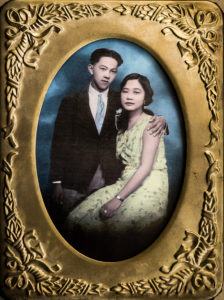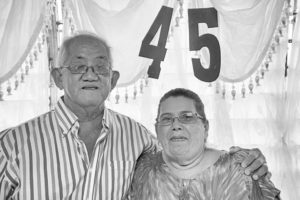By Chevon Lim
There are many reasons why people might start to trace their ancestors. It could be that they are trying to find out something about a grandparent, an interest in history or (most likely) just a curiosity about who their ancestors were and whether they had had inherited any characteristics or skills.

For many people, however, it is not until they start working on their family history that they realise just how it can have very positive effects on their lives and how they feel about themselves. Genealogy can certainly mean different things to different people. For Guyanese Michael Lam, he inherited the interest of uncovering his familial roots from his father, Mr. Christoper Lam, who he said has spent many years collecting the information, and putting it into various forms.
“It is from him that I inherited the interest in our roots, but neither of us has had the time to find out much more than names, the stories still elude us. Much of the information is the product of hard work by Trev Sue-a-Quan and Margery Kirkpatrick, both of whom did extensive research and documentation on the history of Chinese in Guyana, producing several books on the subject,” Mr. Lam explained to the Guyana Times Sunday Magazine. He further explained that the journey began when he was a young boy visiting the Chinese Association as a family. While there, he and his family became interested in the displays of other family trees. He said, “…we hunted, searching for familiar names, I think that this was when my father began to take an interest in finding out more about our roots.”
Interesting facts
While there are many benefits of tracing family genealogy, for the Lam’s, one of the most resounding results has been finding the name of the person who migrated to Guyana from China, the first of the family to live on Guyana’s (British Guiana’s) soil. This Michael explained was “one of the most significant and interesting things.” The family also discovered that their ancestors lived at Victoria Village on the East Coast of Demerara. He added, “My father himself was born in Queenstown, Essequibo Coast, and my siblings and I were born in Georgetown. Typically, the families tended to be large, with the number of children ranging from 7 to 12; our current generation has sadly broken that trend with small numbers of children per person.”
Alluding to the progress made thus far, he noted that while his family has been able to trace their history back six to seven generations on the paternal side, his hopes are that the next generation would take up the mantle and perhaps find out more about their ancestors who lived in China. However, he acknowledged that this may become challenging as time elapses. “Time is not on our side, and as more time passes, the likelihood of finding that information dwindle,” Michael said.

Challenges
According to Mr. Lam, one of the “problematic aspects” of the journey has been access to information, since the family has had to comb through paper-records and not digital files. He added, “There is a lot of legwork involved in seeking out birth records, baptism and marriage records, and if we go farther back it would entail shipping manifests etc.” In describing the process further Michael also told the Guyana Times Sunday Magazine that, despite this, he and his father have made concerted efforts to find ways to keep the records while adding to them. Both he and his father have used several programmes to gather and store the information uncovered. “I think the next step for me would be to try at some point to branch out online to resources such as Ancestry.com,” he added.
In pointing to the many benefits of learning about his family’s history and lineage, Michael emphasised that he now has a better sense of “being”. He explained, “As a youngster, I was only concerned with our nuclear family and the extended ones such as aunts, uncles, cousins who were part of our everyday life, but finding out much of the ancestral tree on both the maternal and paternal side has given a sense of “being”. But I am Guyanese, I know where I belong; what the names in the tree gives me is a sense of who I am, of where I’ve come from.”
Sense of Identity
He further explained that while the benefits of such an undertaking are, in the end, purely personal, he now has an enhanced sense of identity which came from understanding his descendants , knowing where he came from and who to identify with . “It gives me an Identity, a place and a people from which I descended and can now identify with, while still knowing that who I am is not defined by it, but it may help shape who I can be,” Michael stated.
For anyone thinking about embarking on such a journey, Michael advises to start with a basic family tree including parents and grandparents. He explained, “Start asking questions from there. Because of our immigrant past and the strong role religion played in many of our ancestral groupings, the Post Office and the Churches are often the best and more accessible resources.”
Michael C. Lam is a Guyanese photographer. His influences include the work of Ansel Adams, Hiroshi Sugimoto and Darren Moore. He holds a degree in Biology from the University of Guyana, was the Bronze medallist in the 2012 and 2017 Guyana Visual Arts Competition and Exhibition, short-listed in the 2014 edition of the same. Other than having his entries in all three competitions displayed in the exhibition portion, he co-exhibited with fellow photographer Nikhil Ramkarran in the National Gallery at Castellani House in 2012 at an exhibition titled “Coastal Wanderings”. His current Oniabo collection was previewed through a slide-show presentation at Moray House in October of 2014.
In June 2016, his work was chosen as part of a curated Exhibition titled VISIONS at Fitzgerald House, Georgetown, Guyana, alongside 16 other photographers; it was curated by Karran Sahadeo. From July to September 2016, three pieces from his Oniabo collection was chosen as part of a Curated Exhibition titled Un | Fixed Homeland at Aljira, Newark New Jersey. Michael’s pieces were exhibited alongside 12 other artists of Guyanese descent from across the diaspora. One piece was selected for the 2017 curated exhibition Liminal Space, at the Caribbean Cultural Centre African Diaspora Institute (CCCADI) in New York (June to November); his pieces were exhibited alongside 15 other artists of Guyanese descent from across the diaspora, but primarily from the New York area. (Guyana Times Sunday Magazine)



